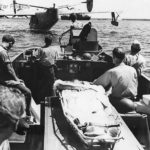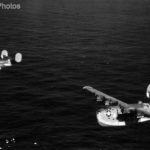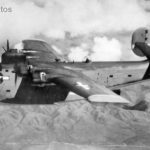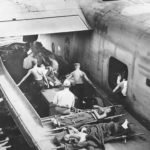PB2Y-3 at Noumea Harbor New Caledonia March 11, 1942
British Coronado GR Mk I JX496 at M&AEE March 1944
PB2Y-2 of the VP-13 November 1940 3
XPB2Y-1 in flight 1938
PB2Y-3 6
Consolidated PB2Y-2 of the VP-13 November 1940 2
Coronado GR Mk I “Beaumaris” of No. 231 Sqn RAF at Bermuda Base
British Coronado GR Mk I JX495 at Helensburgh, 1944
PB2Y at Consolidated Vultee 1943
PB2Y-2 of the VP-13 November 1940
PB2Y at Consolidated Vultee Plant Downey California August 1943
XPB2Y-1 Coronado prototype ready for test flight 1938
PB2Y-5 patrol flying boat during takeoff on water
Consolidated PB2Y-3 Coronado Kaneohe Bay, Hawaii
Prototype Consolidated XPB2Y-1 BuNo 0453 in flight
PB2Y-5 Coronado “white R51” in flight 2
PB2Y-3 in flight 4
PB2Y-3 in flight 5
PB2Y-3 Coronado in flight
Consolidated PB2Y-5 hoisted aboard seaplane tender
Consolidated PB2Y-5 Coronado “white R51” in flight
Consolidated PB2Y-3R anchored on the water
Prototype XPB2Y-1 BuNo 0453 anchored on the water
Landing boat carrying a wounded soldier approaches PB2Y waiting to evacuate the wounded from newly captured Makin
An early Consolidated PB2Y-3 Coronado 3
Members of VPB-15 demonstrate the strength of the PB2Y-5’s wings
A pair of PB2Y on patrol during WWII
Consolidated PB2Y-2
Consolidated PB2Y-2 13-P-1 of the VP-13 on beaching gear
Coronado that lost a wing tip float 29 October 1943
PB2Y-2 Coronado of the VP-13 in flight
Transport flying boat Consolidated PB2Y-2 Coronado takeoff
Fying boat PB2Y-2 Coronado 3
XPB2Y-6 Coronado fitted with Wright R-2600 Twin Cyclone engines December 30, 1944
Transport aircraft PB2Y-3R Coronado BuNo 7239 on beaching gear
Fying boat PB2Y-3 in flight
Coast Guard small craft supports efforts to right a PB2Y-3 that capsized when it lost a wing float 29 October 1943
Antisubmarine PB2Y-3 Coronado P-68 of VPB-1 Galapagos, Seymour Island, Ecuador
WAVES from Hunter College Visit Coronado at LaGuardia February 1944
PB2Y-2 BuNo 1633 code 13-P-1 of the VP-13 in flight
Fying boat PB2Y-3 3
PB2Y-2 BuNo 1633 code 13-P-1 of the VP-13 in flight 2
A pair of PB2Y 2
Consolidated PB2Y-5
Landing boat takes wounded to Coronado for evacuation at Makin
Fying boat PB2Y-3 on beaching gear
PB2Y-5 Coronado making a jet assisted take at San Diego
PB2Y-5H Coronado ambulance airplane
PB2Y-3R BuNo 7052 takeoff 1943
The Consolidated PB2Y, along with the Sikorsky PBS and Martin PB2M, was one of the large, four-engine flying boats developed to fulfill the Navy’s “Sky Dreadnought” concept, which aimed to have long-range bombers operate from widely dispersed sea bases while also serving traditional maritime patrol functions. Consolidated was awarded a contract on July 27, 1936, to build one flying prototype of the Model 29 under the designation XPB2Y-1. Although it shared some features with its PBY predecessor, such as folding wing floats and a cruciform tail group with a single fin and rudder, the XPB2Y-1 had a deeper hull with a fully-cantilevered wing mounted directly atop the fuselage without any supporting pylon. Its higher aspect ratio wing, swept from the leading edge, carried a load factor of approximately 133 kg/m² (30 lbs. per sq. ft.), which was about thirty percent higher than that of the contemporaneous PBY-2. Except for moveable control surfaces, the entire structure was skinned in stressed aluminum. The aircraft achieved a very clean overall configuration by housing all droppable munitions in flush bays under the wings. The XPB2Y-1 made its first flight from San Diego on December 17, 1937, but serious problems with directional stability were encountered, requiring finlets to be added to the horizontal stabilizers after the third flight. Further testing revealed continuing stability problems and the need to improve the hydrodynamic characteristics of the hull planing surfaces. The prototype returned to the factory and emerged in mid-1938 with a totally redesigned empennage that had twin circular fins and rudders end-mounted to a new horizontal stabilizer with about six degrees of dihedral. The rear step had been lengthened to extend almost halfway to the tail to enhance hull performance. Following suitability trials, the Navy accepted the XPB2Y-1 and assigned it to the Aircraft Scouting Force as the admiral’s “flagship.” In March 1939, BuAer authorized Consolidated to build six PB2Y-2s after virtually redesigning the hull. The hull was deepened, which allowed the wing to be moved down to a shoulder position on the fuselage. Streamlining and hydrodynamics were improved by smoothing the bow into a reshaped nose turret. The fins and rudders were enlarged, similar to those of the Model 31 (see P4Y), and the available horsepower was boosted by fifteen percent with an upgrade to R-1830-78 engines. The first PB2Y-2, named “Coronado” by the factory, was delivered to the Navy on December 31, 1940, and four more were accepted by mid-1941. Circular windows appeared on each side in the waist, and a dorsal blister behind the wing housed new gunner’s positions.
The PB2Y flying boat underwent several modifications and production variants during its service with the Navy. While the empty weight increased by 3,402 kg (7,500 lbs.), the top speed of the latest model, the PB2Y-3, improved to 410 km/h (255 mph) at 5,791 m (19,000 ft), making it the fastest in the series. Additionally, its normal range was nearly double that of the PBY-5. The Navy primarily used the five PB2Y-2s it received for operational training and evaluation, and the sixth PB2Y-2 was modified to the updated production standard and designated as the XPB2Y-3. Another PB2Y-2, equipped with Wright R-2600 Twin Cyclone engines, later became the XPB2Y-4. The main concern of the Navy regarding the production of the PB2Y was its cost, as three PBYs could be purchased for the price of one PB2Y (approximately $300,000). As a result, the Navy preferred to invest in a larger number of twin-engine patrol aircraft distributed over a wider area of the ocean, which was deemed a better long-term strategy, particularly in the Pacific. In November 1940, Consolidated received a contract for 210 production aircraft, of which 177 were to be delivered to the Navy as the PB2Y-3 and thirty-three to Great Britain as the PB2Y-3B. The PB2Y-3 was heavier by 2,585 kg (5,700 lbs.) and featured self-sealing fuel tanks, 907 kg (2,000 lbs.) of armor protection in vital areas, twin-gun power-operated turrets in the bow, dorsal, and tail positions, and two flexible waist guns. Production of the PB2Y-3s began in the summer of 1942, but by that time, the Navy had already shifted its focus to building a fleet of fast carriers using smaller aircraft for bombing missions. As a result, the PB2Ys were repurposed as over-ocean transports due to their large cargo capacity and superior range. When 136 PB2Y-3s had been delivered by October 1943, the remaining 41 airframes were completed by Rohr Aircraft Corp. as unarmed PB2Y-3R transports, which were 3,628 kg (8,000 lbs.) lighter and could carry up to forty-four passengers or 7,257 kg (16,000 lbs.) of cargo. Only ten PB2Y-3Bs were ultimately delivered to Britain, where they were stripped of armament and used exclusively as transatlantic transports. As Navy land-based aircraft (such as the PB4Y Liberators) took over the maritime patrol role, most PB2Y-3s were withdrawn from patrol units and converted to serve as transports. Some PB2Y-3s were fitted with low-altitude R-1830-92 engines with single-stage superchargers and returned to service as PB2Y-5Rs, while others received a new cabin arrangement for twenty-five medical litters and became the PB2Y-5H. All PB2Ys were retired from Navy service shortly after the end of World War II. Due to limited demand for large flying boats in the post-war period, there was practically no market for surplus PB2Ys.
Design and Structure
- Type: Four-engined patrol bomber (PB2Y-3) or transport flying-boat (PB2Y-3R).
- Wings:
- Configuration: High-wing cantilever monoplane mounted directly to the top of the hull, tapering in chord and thickness with a swept-back leading-edge and straight trailing-edge.
- Design: All-metal structure with stressed aluminum-alloy skin. The entire trailing-edge is hinged, with the outer portions serving as ailerons and the inner portions (between the ailerons and the hull) functioning as flaps. Both ailerons and flaps have metal frames and are fabric-covered.
- Hull:
- Design: Two-step, semi-circular-topped hull of all-metal construction, with the after step terminating in a vertical knife-edge. The hull is treated with anti-corrosion finishes inside and out. Stabilizing floats are retractable and form wing-tips when not deployed, with their supporting struts recessed flush with the underside of the wings.
- Tail Unit:
- Type: Cantilever monoplane type with twin fins and rudders.
- Structure: All-metal with fabric-covered elevators and rudders. The movable surfaces are statically and aerodynamically balanced and include trimming-tabs.
Power Plant
- Engines:
- Models: Four Pratt & Whitney R-1830-88 engines for PB2Y-3 or R-1830-92 engines for PB2Y-5 and PB2Y-3R.
- Type: Radial air-cooled engines, mounted in line along the leading-edge of the wings with NACA cowlings.
- Propellers: Hamilton-Standard Hydromatic full-feathering airscrews.
Accommodation and Armament
- Accommodation:
- Patrol-Bomber Version (PB2Y-3 and 5): Crew of ten, with internal arrangements including sleeping quarters, galley (with electric range and refrigerator), workshop, independent electric generating system, and intercommunication telephone system. Equipped with breaching gear and lifting slings for engines.
- Transport Version (PB2Y-3R): Maximum cargo capacity of 16,000 lbs. (7,264 kg.), featuring strengthened flooring, a large loading door, and facilities for cargo handling.
- Armament:
- Weaponry: Three power-operated turrets armed with .50 cal. machine guns. Stowage for bombs or depth-charges is located in the wings.
Dimensions and Loadings
- Dimensions:
- Span: 115 ft. (35 m)
- Length: 79 ft. 3 in. (24.2 m)
- Height: 27 ft. 6 in. (8.4 m)
- Wing Area: 1,780 sq. ft. (175.4 sq. m)
- Weights:
- Maximum Cargo Capacity: 16,000 lbs. (7,264 kg)
- Maximum Loaded Weight: 66,000 lbs. (29,964 kg)
Performance
- Maximum Speed: 194 mph (310.4 km/h)
- Cruising Speed: 170 mph (272 km/h)
- Maximum Range: 1,070 miles (1,710 km) at 131 mph (210 km/h)
















































